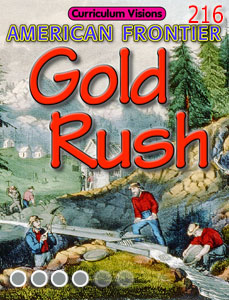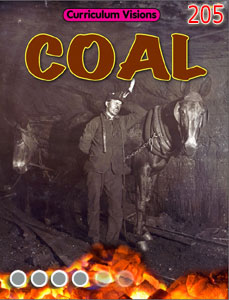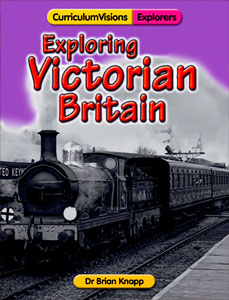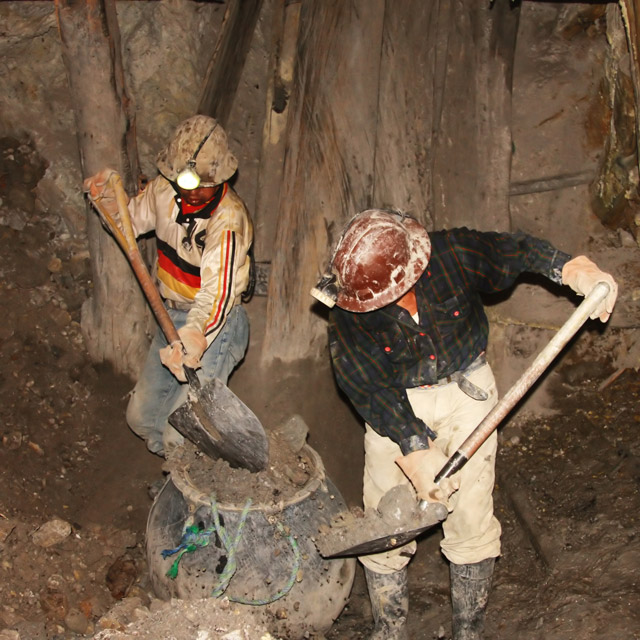Mining is the business of digging for valuable materials from within Earth. This may be coal, oil, gold, tin, silver, limestone, or anything else that people need and which lies below the surface.
You can mine in two ways: you can dig a vertical pit (called a shaft) until you reach the material you want; or you can dig away the overlying rock as though you were digging a quarry. That is open-cast mining.
The earliest mining was through shafts. Even in Stone Age times, people were able to dig into chalk, for example, until they came across a seam of flints, then dig around to get as many flints as they could. The shafts (known as bell pits) were mostly just a few meters deep, but it was true mining. The mines at Grimes Graves were dug between 6000 and 5000 years ago.
In South Africa, people dug a mine 43,000 years ago to reach red iron ore, and crush it to make a colour for cave painting.
Although most ancient civilizations preferred to dig rocks from the surface in quarries, in the case of gold this was not possible. The Ancient Egyptians, for example, had gold mines in Nubia.
The Greeks, and especially the Romans, went in for mining on an industrial scale. They needed iron, tin and other metals, and they had to dig for them.
In the Middle Ages in Europe, mining was mostly for copper and iron. Other precious metals were also used mainly for coins. By the 14th century, the demand for weapons and armour meant that the iron mining industry was very important. In the Age of Discovery, Europeans discovered that peoples in the Americas had also found how to mine and work with metal. That was what they wanted to conquer for. The gold and silver mostly came from mines in Central and South America.
But the deeper people dug, the more likely they would be to flood, as water seeped in through the walls of the mine. There was no way of getting the water out fast enough until the invention of the steam engine.
By the time of the 19th century there were some mines using pumps to keep them dry, but there was still a huge number of mines that were dug in the way they had been for thousands of year.
This was the age of the California's Gold Rush of 1848-9, and the gold rushes in Canada, Australia and South Africa. But these miners were all looking for gold and silver that had been washed out of rocks by rivers (they are called placer deposits). They did not want to mine more than they had to.
But most metal does not occur in pure form (known as native metal) and it is commonly just a few per cent of the rock that is mined. So, over time, these small-scale mines gave way to a smaller number of very large mines that used machines to dig, crush and separate rock from metal. That is what the industry is mostly like today.
Machines are so big that much mining is by open-cast methods, not deep shaft mining. As a result, it disturbs large areas of the surface and many people worry about its effect on the environment.
But as we make more and more things with metal (such as electronics), and countries like China and India grow rapidly, they demand more and more metal, and so mining is a bigger industry than it has ever been. And metal needs grow in developed countries, too. For example, between 1932 and 1999, copper use in the USA rose from 73kg/160lb to 238kg/525lb per person.
Levels of metals recycling are still low. A lot of mining could be saved if we all recycled more.
CASE STUDY: THE CORNISH TIN AND COPPER MINES, ENGLAND
We are looking at the rugged coast of Cornwall very close to Land's End in England. It is a country of hard rocks battered by waves. It is a wild and beautiful area, but for many centuries it was also a place where thousands of people toiled deep underground. They have left behind only the smoke stacks that went with the engines that lifted metal ore from the mines and lowered people in and gone are the myriad of buildings, homes and more.
But why should they all be attracted to this, and some other places dotted around the hard rocks of Cornwall and Devon? Are not metal mines connected to mountains? There are no mountains here.
Well, yes there are. In fact, you are looking at the roots of very ancient mountains now. And it is deep inside mountain ranges that precious minerals like silver, gold, copper and tin, as well as gemstones are found.
In a way, nature has done part of the miners' job for them, by wearing away mountaintops to low land. It took some 400 million years, but now the roots of the mountains are laid bare. That is what these cliffs are.
At the heart of these mountains were giant magma chambers that fed exploding volcanoes. The pressure in these magma chambers was immense, often cracking the rocks above. This allowed the most runny part of the magma to flow up, away from the chamber and into the cracks in the rocks above. Here it cooled, and metals and minerals changed from solids to liquids, according to the temperature at which they melted. Those with the highest melting points solidified first, those with the lowest melting points went farthest into the cracks and solidified last. As a result, each crack – which miners call veins – is a long thin source of wealth, with different metals and minerals along its length.
But it is not pure metal. On average, about 1 per cent is metal in among 99% waste rock. So when the mined rock reached the surface it still had to be crushed and treated with chemicals to extract the metal.
By just looking at the cliffs you can see how broken the rock is. Where there is a cove, there is region of very broken - and so less resistant rock. You can tell one other thing from these pictures, and that is the lines of broken rock are set vertically, and that many run out to sea. And it is in these more cracked rocks that the mineral wealth lies – including in rocks under the sea. That is why the mines are on the top of the cliffs, and that is why miners have gone deeper and deeper into the ground for centuries. It is also why some mines are perched on the cliff edges, for the tunnels of those mines go far out under the sea – despite the frequent risk of the mines flooding.
Tin and copper are the metals most commonly found here. The Celts knew of them, and the Romans knew of them. But it was not until Tudor times that mining became more important. At this time tin mines - which were locally called wheals - became important as a source of tax money for the monarch.
Mining was all done by hand, and it involved thousand upon thousand of people. It created jobs, and as people came to the area to work in the mines, it also created many new towns and even ports. Very skilled and able people worked here, finding new techniques for mining and for extracting metal from the rock, known as ore.
In the early 19th century these mines produced two-thirds of the world's supply of copper, and in the late 19th century half of the world’s arsenic.
One of the most important innovations was the steam engine, whose job was not just to move men and rock, but also to keep water pumped from the mines. Water was always leaking from the rock into the tunnels and shafts. Famous steam engine and railway engineers such as Richard Trevithick and Arthur Woolf worked here.
But, as with all mining areas, it is a place of boom and bust. In time it was affected by copper and tin being mined more cheaply in other parts of the world. That is why the mines gradually closed. Then the bricks from the mine buildings were taken away and used elsewhere, and miners drifted away in search of new jobs. Today jot is hard to see the extent of the mines as you walk around the cliffs, for much of the area is overgrown, but from the air it is very clear how the mines covered huge areas.
Botallack, which you see here, was a submarine mine, with tunnels extending under the sea, in places for a kilometre at depths of 500 metres. From these tunnels came 14,500 tonnes of tin, 20,000 tonnes of copper and 1,500 tonnes of arsenic. But it came at a cost. To get these minerals, one and a half million tonnes of waste rock had to be dug up, and the rock crushed and treated to get the minerals out. Other mines were even more vast. The Geevor mine dug 140km of tunnels, and needed 4 million litres of water to be pumped out every single day.
As the opportunities ran out in Cornwall, so these highly skilled miners were attracted to other mining areas around the world. Many Cornish miners tried their hand in the Californian Gold Rush, the Klondyke and elsewhere. And that is why so many mining towns of America, Australia, Canada and other countries have strong Cornish heritage connections.







